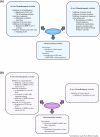Hesperidin and its aglycone hesperetin in breast cancer therapy: A review of recent developments and future prospects
- PMID: 34866972
- PMCID: PMC8626310
- DOI: 10.1016/j.sjbs.2021.07.046
Hesperidin and its aglycone hesperetin in breast cancer therapy: A review of recent developments and future prospects
Abstract
Breast cancer (BC) has high incidence and mortality rates, making it a major global health issue. BC treatment has been challenging due to the presence of drug resistance and the limited availability of therapeutic options for triple-negative and metastatic BC, thereby urging the exploration of more effective anti-cancer agents. Hesperidin and its aglycone hesperetin, two flavonoids from citrus species, have been extensively evaluated for their anti-cancer potentials. In this review, available literatures on the chemotherapeutic and chemosensitising activities of hesperidin and hesperetin in preclinical BC models are reported. The safety and bioavailability of hesperidin and hesperetin as well as the strategies to enhance their bioavailability are also discussed. Overall, hesperidin and hesperetin can inhibit cell proliferation, migration and BC stem cells as well as induce apoptosis and cell cycle arrest in vitro. They can also inhibit tumour growth, metastasis and neoplastic changes in tissue architecture in vivo. Moreover, the co-administration of hesperidin or hesperetin with doxorubicin, letrozole or tamoxifen can enhance the efficacies of these clinically available agents. These chemotherapeutic and chemosensitising activities of hesperidin and hesperetin have been linked to several mechanisms, including the modulation of signalling pathways, glucose uptake, enzymes, miRNA expression, oxidative status, cell cycle regulatory proteins, tumour suppressor p53, plasma and liver lipid profiles as well as DNA repair mechanisms. However, poor water solubility, extensive phase II metabolism and apical efflux have posed limitations to the bioavailability of hesperidin and hesperetin. Various strategies for bioavailability enhancement have been studied, including the utilisation of nano-based drug delivery systems and the co-administration of hesperetin with other flavonoids. In particular, nanoformulated hesperidin and hesperetin possess greater chemotherapeutic and chemosensitising activities than free compounds. Despite promising preclinical results, further safety and efficacy evaluation of hesperidin and hesperetin as well as their nanoformulations in clinical trials is required to ascertain their potentials to be developed as clinically useful agents for BC treatment.
Keywords: Bioavailability; Biosafety; Breast cancer; Hesperetin; Hesperidin; Nanoformulation.
© 2021 The Author(s).
Conflict of interest statement
The authors declare that they have no known competing financial interests or personal relationships that could have appeared to influence the work reported in this paper.
Figures





Similar articles
-
Bioavailability of Hesperidin and Its Aglycone Hesperetin-Compounds Found in Citrus Fruits as a Parameter Conditioning the Pro-Health Potential (Neuroprotective and Antidiabetic Activity)-Mini-Review.Nutrients. 2022 Jun 26;14(13):2647. doi: 10.3390/nu14132647. Nutrients. 2022. PMID: 35807828 Free PMC article. Review.
-
The effect of co-administered flavonoids on the metabolism of hesperetin and the disposition of its metabolites in Caco-2 cell monolayers.Mol Nutr Food Res. 2010 Jun;54(6):851-60. doi: 10.1002/mnfr.200900183. Mol Nutr Food Res. 2010. PMID: 20112299
-
Nanophytosomes of hesperidin and of hesperetin: Preparation, characterization, and in vivo evaluation.Biotechnol Appl Biochem. 2023 Apr;70(2):846-856. doi: 10.1002/bab.2404. Epub 2022 Oct 17. Biotechnol Appl Biochem. 2023. PMID: 36112716
-
Metabolism and transport of the citrus flavonoid hesperetin in Caco-2 cell monolayers.Drug Metab Dispos. 2008 Sep;36(9):1794-802. doi: 10.1124/dmd.107.019943. Epub 2008 May 30. Drug Metab Dispos. 2008. PMID: 18515333
-
Recent understanding of the mechanisms of the biological activities of hesperidin and hesperetin and their therapeutic effects on diseases.Heliyon. 2024 Feb 28;10(5):e26862. doi: 10.1016/j.heliyon.2024.e26862. eCollection 2024 Mar 15. Heliyon. 2024. PMID: 38486739 Free PMC article. Review.
Cited by
-
_targeting Cell Signaling Pathways in Lung Cancer by Bioactive Phytocompounds.Cancers (Basel). 2023 Aug 5;15(15):3980. doi: 10.3390/cancers15153980. Cancers (Basel). 2023. PMID: 37568796 Free PMC article. Review.
-
Hesperidin Inhibits Lung Cancer In Vitro and In Vivo Through PinX1.Front Pharmacol. 2022 Jul 1;13:918665. doi: 10.3389/fphar.2022.918665. eCollection 2022. Front Pharmacol. 2022. PMID: 35847001 Free PMC article.
-
In Vitro and In Vivo Anti-Cancer Activity of Lasiokaurin in a Triple-Negative Breast Cancer Model.Molecules. 2023 Nov 22;28(23):7701. doi: 10.3390/molecules28237701. Molecules. 2023. PMID: 38067432 Free PMC article.
-
Recent Advances in Pharmaceutical Cocrystals: A Focused Review of Flavonoid Cocrystals.Molecules. 2023 Jan 6;28(2):613. doi: 10.3390/molecules28020613. Molecules. 2023. PMID: 36677670 Free PMC article. Review.
-
Study of hesperetin effect on modulating transcription levels of MLH1 and MSH2 genes in SKBR3 breast cancer cell line.J Adv Pharm Technol Res. 2023 Oct-Dec;14(4):338-344. doi: 10.4103/JAPTR.JAPTR_278_23. Epub 2023 Oct 30. J Adv Pharm Technol Res. 2023. PMID: 38107455 Free PMC article.
References
Publication types
LinkOut - more resources
Full Text Sources
Research Materials
Miscellaneous

